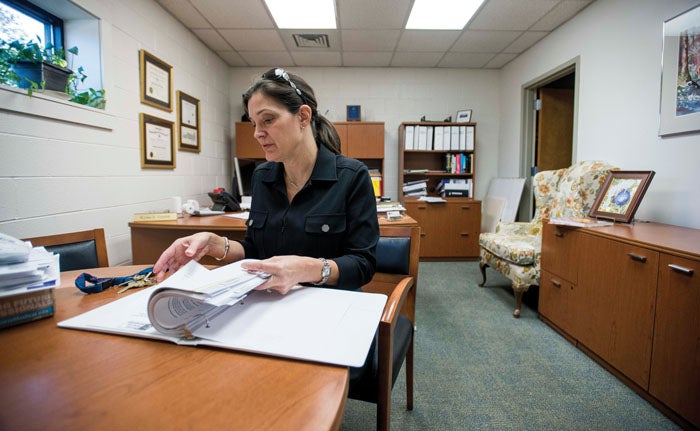Rowan Helping Ministries hopes Miracles on the Horizon can raise $6 million
Published 10:35 pm Saturday, September 3, 2022

- JON C. LAKEY / SALISBURY POST File Photo — Kyna Grubb , RHM executive director, looks through a handbook for volunteer opportunities.
By Elizabeth Cook
For the Salisbury Post
Rowan Helping Ministries is stepping up efforts to fight homelessness with an ambitious plan to more than double its transitional and permanent supportive housing and expand other supportive services.
A $6 million capital campaign to fund the endeavor, “Miracles on the Horizon,” will have a public launch on Sept. 21 with a 9:30 a.m. event at the Historic Salisbury Station.
The goal, says Executive Director Kyna Grubb, is to help more people find their pathways home.
“We want to do more than give a man a fish,” Grubb says. “We aren’t really helping people if we aren’t helping them to help themselves.”
Based on North Long Street for 35 years, Rowan Helping Ministries may be best known for its soup kitchen and overnight shelter. It also has long offered crisis assistance, a clothing closet and food pantry.
Transitional housing was added several years ago under then-director Dianne Scott. For those who qualify, the program provides a low-cost place to stay for 18 to 24 months. Participants are required to work, pay a program fee and attend self-improvement programs.
Permanent supportive housing goes beyond that, providing a cost-effective solution to low-income, disabled individuals who need supportive services to live independently. They also are required to work, pay a fee and participate in programs.
Working from a strategic plan, Grubb and her board members have looked forward to growing this part of the ministry. They want to help more people in crisis look beyond the next meal or the next night’s sleep and find lasting ways to improve their lives.
Projects
The capital campaign would fund several projects:
• Eagle’s Nest III, two transitional housing buildings, would add 12 apartments to the 10 units now in Eagle’s Nest I and II. Estimated cost: $1.7 million.
• Five new duplexes would serve as permanent supportive housing for individuals, couples and families in transition. Cost: $1.5 million
• Renovation of the historic R.B. Miller building by the railroad tracks would create offices for case management, counseling and administration, as well as a “Living Room.” Cost: $1.2 million.
• Remodeling of the agency’s Ralph W. Ketner Center would make space for medical and mental health services. Cost: $90,000.
• A maintenance reserve fund would be set aside for major equipment repairs and replacements in the Ralph Ketner and Robertson-Stanback centers. Goal: $1 million
While the estimates total $5.6 million, Grubb says inflation has raised the projected need to $6 million.
The cost would be higher — much higher — if not for partnerships with several other agencies.
Partners
Eagle’s Nest III has multiple partners: the Veterans Administration, Historic Salisbury Foundation and the R.B. Miller Family.
The VA has been running a transitional housing program through the shelter for some time. Now the VA is giving Rowan Helping Ministries $450,000 toward true transitional housing in Eagles Nest III. Nine of the 12 new units will serve vets. (Three of the 10 existing units are now dedicated to veterans.)
Historic Salisbury Foundation and the Miller family are donating land near the railroad tracks for the transitional housing. The Miller property includes two historic buildings that will retain their combined 19th century façade with one building creating office space, while a new structure will house six apartments and space for offices. Architect Gray Stout and contractor Chad Vreisema are working on the project.
First Horizons Neighborhood: First Horizons Bank stepped up with $200,000 in seed money for the new duplexes to create the “First Horizons Neighborhood” on East Council Street. First Horizons is also providing a $2 million loan. Pete Bogle is the architect for this permanent supportive housing.
Ketner Building: Renovations will take place at the North Long Street building that first housed Rowan Helping Ministries, the structure bearing the name of the late Ralph W. Ketner, a Food Lion co-founder and philanthropist.
Grubb and other administrative staff would move out of the building to make way for Cabarrus-Rowan Community Health Centers (CRCHC) to operate a mental health and medical clinic 40 hours a week.
Rowan Helping Ministries has long seen a need for these services but cannot deliver them directly itself.
“We try to stay in our lane,” Grubb says.
At the moment, CRCHC offers medical and mental health services on site two days a week. This renovation will help to expand service hours and assist more clients. Once health services open on the Rowan Helping Ministries complex, Grubb says, staff members can walk clients to the facility.
Living Room: S&H Youth and Adult Services will operate the Peer Support Living Room in the Miller Building. In this space, clients could meet with peer support specialists as soon as possible in a comfortable, calm environment to de-escalate mental health crises, avoid hospitalization and stay in a stable housing situation.
Another Miracle
Rowan Helping Ministries’ strategic plan drives this project. Devised with 2019-21 in mind and extended because of COVID, the plan covers everything from “Increase emphasis on solving core issues faced by clients” to “Ensure ability to grow programs and services around educating and empowering clients.”
In 2014, the agency dedicated its newest building, the 20,000-square-foot Robertson-Stanback Center on North Long Street, across from the original shelter. The building houses Jeannie’s Kitchen and a bigger overnight shelter. That was the result of a $5.8 million fundraising effort called the Miracle on Long Street.
“Expanding to the shelter across the street addressed the growing needs for homelessness outside of the men’s shelter we were originally built to be,” Grubb says. “We had more women, and then we started seeing a lot of families.”
Families with children now make up about 30% of the nation’s homeless population, according to the National Alliance to End Homelessness. Getting them into a home can be complicated.
“We have this great homeless shelter that has a lot of resources around it to help people move to housing,” Grubb says, “but that pathway to housing is unique to each individual.”
People who are not ready for housing are not successful in it, she says. Readiness includes the ability to pay, having basic housekeeping skills, being able to maintain a home, having wraparound services for health needs and — perhaps toughest of all — finding a place that is affordable.
That said, Rowan Helping Ministries could fill its transitional and permanent housing units many times over. Grubb recalls the time they had 19 families that qualified for permanent supportive housing, and across a five-county area only two were placed all year.
But those who are placed get results that are worth the wait.
Grubb remembers the woman who was seeking assistance for herself and her disabled child. She moved into permanent supportive housing and could not even save up $7 the first week. Yet within a few years she was able to get her own home.
“The goal is to help people stabilize and move on,” Grubb says.


